You're using an outdated browser. Please upgrade to a modern browser for the best experience.

Submitted Successfully!
Thank you for your contribution! You can also upload a video entry or images related to this topic.
For video creation, please contact our Academic Video Service.
| Version | Summary | Created by | Modification | Content Size | Created at | Operation |
|---|---|---|---|---|---|---|
| 1 | Pavlos Nikolaidis | -- | 4649 | 2023-09-26 07:32:46 | | | |
| 2 | Jessie Wu | + 2 word(s) | 4651 | 2023-09-27 03:02:08 | | |
Video Upload Options
We provide professional Academic Video Service to translate complex research into visually appealing presentations. Would you like to try it?
Cite
If you have any further questions, please contact Encyclopedia Editorial Office.
Nikolaidis, P. Direct Methods for Solar Energy Harnessing. Encyclopedia. Available online: https://encyclopedia.pub/entry/49624 (accessed on 29 December 2025).
Nikolaidis P. Direct Methods for Solar Energy Harnessing. Encyclopedia. Available at: https://encyclopedia.pub/entry/49624. Accessed December 29, 2025.
Nikolaidis, Pavlos. "Direct Methods for Solar Energy Harnessing" Encyclopedia, https://encyclopedia.pub/entry/49624 (accessed December 29, 2025).
Nikolaidis, P. (2023, September 26). Direct Methods for Solar Energy Harnessing. In Encyclopedia. https://encyclopedia.pub/entry/49624
Nikolaidis, Pavlos. "Direct Methods for Solar Energy Harnessing." Encyclopedia. Web. 26 September, 2023.
Copy Citation
The escalating concerns regarding greenhouse gas (GHG) emissions and finite fossil fuel resources have propelled scientists and engineers to explore alternative and renewable energy sources (RES). Among these, solar energy stands out as a remarkable prospect because it is abundant, renewable, and emits no direct pollutants during operation. The fundamental principles of solar energy conversion through photovoltaic technology is introduction, shedding light on the progress and potential of harnessing the sun’s energy for a cleaner, sustainable energy future.
solar energy
sustainable energy systems
climate change
de-carbonization
renewable energy sources
energy harnessing technologies
1. Introduction
Solar energy can be directly used with the aid of some well-known processes. Either immediately in the form of heat or after its conversion into electricity, this kind of renewable energy sources (RES) can be used for the most common services such as space heating, domestic hot water, water pumping, seawater desalination, cooking, and so on. Figure 1 accommodates the direct harnessing methods along with the mechanisms that allow for the solar energy to be stored and used when needed, also referred to as indirect methods.
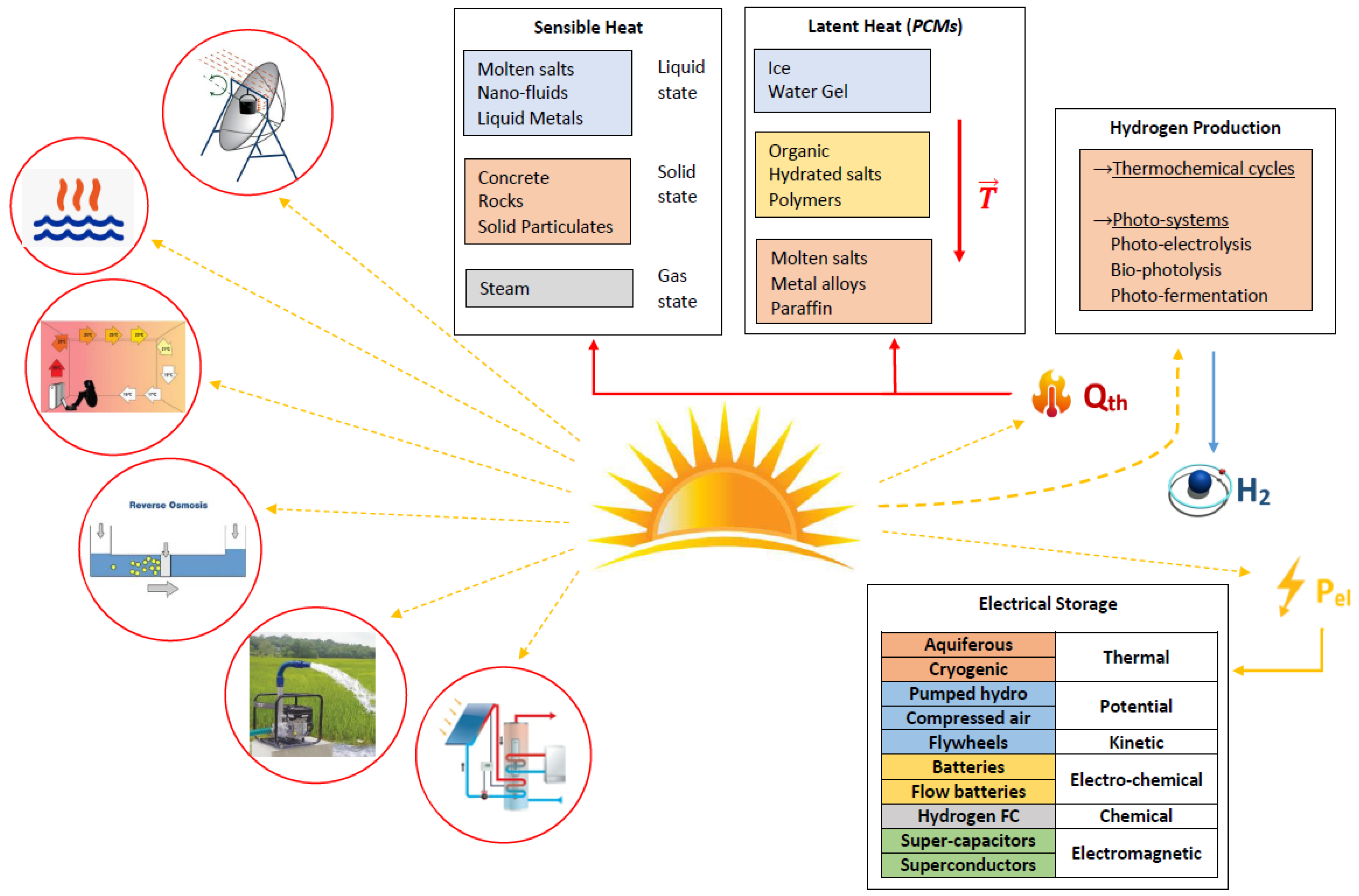
Figure 1. Direct and indirect methods for solar energy harnessing.
2. Space Heating/Cooling
The energy stemmed from the sun can facilitate the transition from the currently active to the modern passive houses (Passivhaus), nearly-zero energy buildings (nZEBs), and net-zero energy buildings (NZEBs). Passive houses (PHs) maintain comfortable and pleasant temperatures throughout the year with minimal energy consumption, regardless of climate or region. They utilize solar heat, internal heat sources, and heat recovery efficiently, so that even on cold winter days, there is no need for a conventional heating system [1].
In Central Eope, PHs use up to 90% less energy for heating than conventional houses, requiring less than 1.5 L of oil or 1.5 cubic meters of natural gas per year to heat one square meter of a dwelling [2][3]. A passive house of 100 square meters costs 10% more than a standard house. This cost is negligible compared with the energy savings achieved by a PH.
It is noted that the financial benefits come not only from the obvious reduction in the cost of energy consumed but also from the increase in the value of the building, the improvement of the performance of the mechanical equipment, the reduction of maintenance costs, etc. However, there are also the operational benefits, which help manage the building by improving comfort and safety levels as well as overall operation and efficiency. Last and one of the most important benefits are the environmental benefits that mainly concern the reduction of carbon dioxide emissions and/or other pollutants (including greenhouse gases (GHGs)), the reduction of energy needs, and the preservation of natural resources, while simultaneously improving the environmental profile of the building [4].
However, PHs, nZEBs, and NZEBs pose certain disadvantages, which are fortunately limited [3][5][6][7]. First, in the case of poor construction, negative effects appear. More specifically, the disadvantages concern the existence of noise as well as the risk of thermal losses. Another disadvantage is the limitation of space due to larger masonry [8]. There may still be difficulties in converting a conventional building into a passive one due to spatial constraints. Finally, there is a lack of suitable manufacturers, contractors, and materials for the construction of passive buildings.
The mechanisms that enable passive heating are known as passive solar heating systems. Passive solar heating systems are the structural elements of the building that, utilizing the principles of physics (the laws of heat transfer), collect solar energy, store it in the form of heat, and distribute it in the space without active mechanical systems. The collection of solar energy is based on the greenhouse effect, and in particular, the entry of solar radiation through glass or other transparent material and the trapping of the resulting heat inside the space covered by the glass [9]. They are usually attached to south-facing building facades (for northern latitudes), which should not be shaded during the winter. Passive solar technologies are combined with the required thermal protection (thermal insulation) as well as the required thermal mass of the building or the use of phase change materials to store and deliver heat to the space with a time delay.
Passive solar systems are divided into three main categories based on the way they capture and release solar heat, namely direct, indirect, and isolated gain systems. Direct solar gain is the easiest and least expensive way to heat a space [10]. The sun’s heat is collected and stored indoors. Solar radiation enters through a glass opening oriented to the south and heats the space. This solar radiation is absorbed by structural elements such as walls and floors. The thermal mass of these structural elements helps to minimize sudden temperature changes from day to night and also stores heat during periods without sunlight. The conditions required for the efficient operation of the system are the following: (a) a south conservatory with a large area; (b) the thermal mass inside the building is large enough to absorb temperature changes; and (c) insulation on the outer side of the shell.
In indirect-gain systems, thermal mass collects and stores heat directly from the sun and then transfers it indoors. The main difference with direct solar gain systems is that the sun’s rays do not cross the space since the thermal mass is essentially an external surface in the south. Isolated-profit systems are similar to indirect-profit systems. Their difference is that the collection surface and the heat reservoir are separated. Typical examples of an isolated gain system are the attached greenhouse and the thermosiphon panel. Figure 2 includes some representative systems of solar passive systems, including solar chimneys, thermal-mass walls, greenhouses, solar patios, the Trombe wall with its variations, physical and technical shades, and air vents.
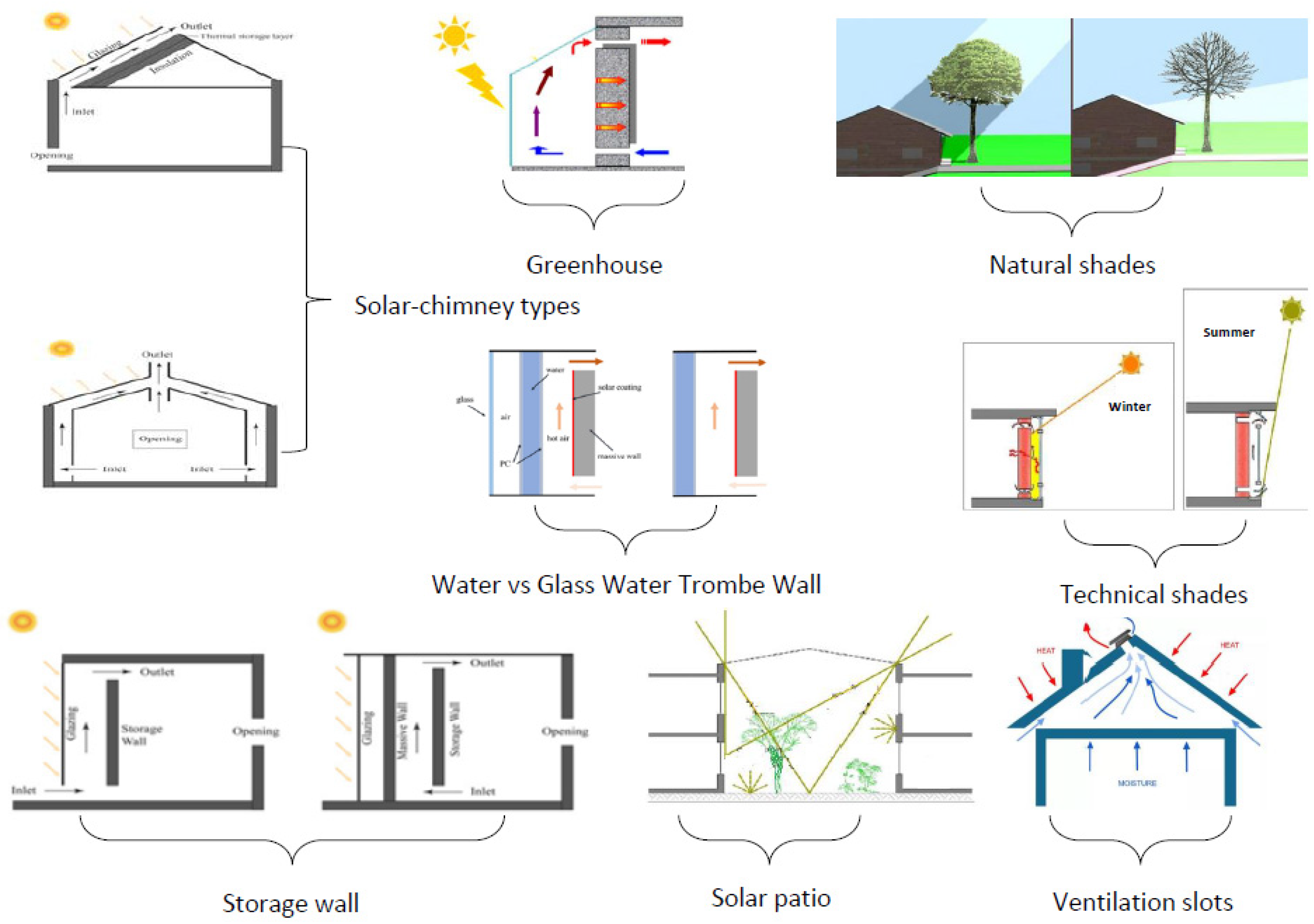
Figure 2. Passive systems for solar space heating.
3. Domestic Water for Use or Space Heating
There are two different ways to convert solar energy into hot water for use: the direct conversion using solar panels and the indirect conversion using photovoltaics to produce electricity, which is used to heat the water by means of a thermal element or a heat pump. It is possible for a system to contain all systems simultaneously by using a heat exchanger with multiple inlets for thermal elements. Solar space heating collectors have gained significant interest in the last decade as they are considered a viable and efficient solution for space heating applications. The most common structure of a system is demonstrated in Figure 3, where the provided service is carried out either by solar thermal through collectors or solar electricity via PVs and electric heaters or heat pumps.
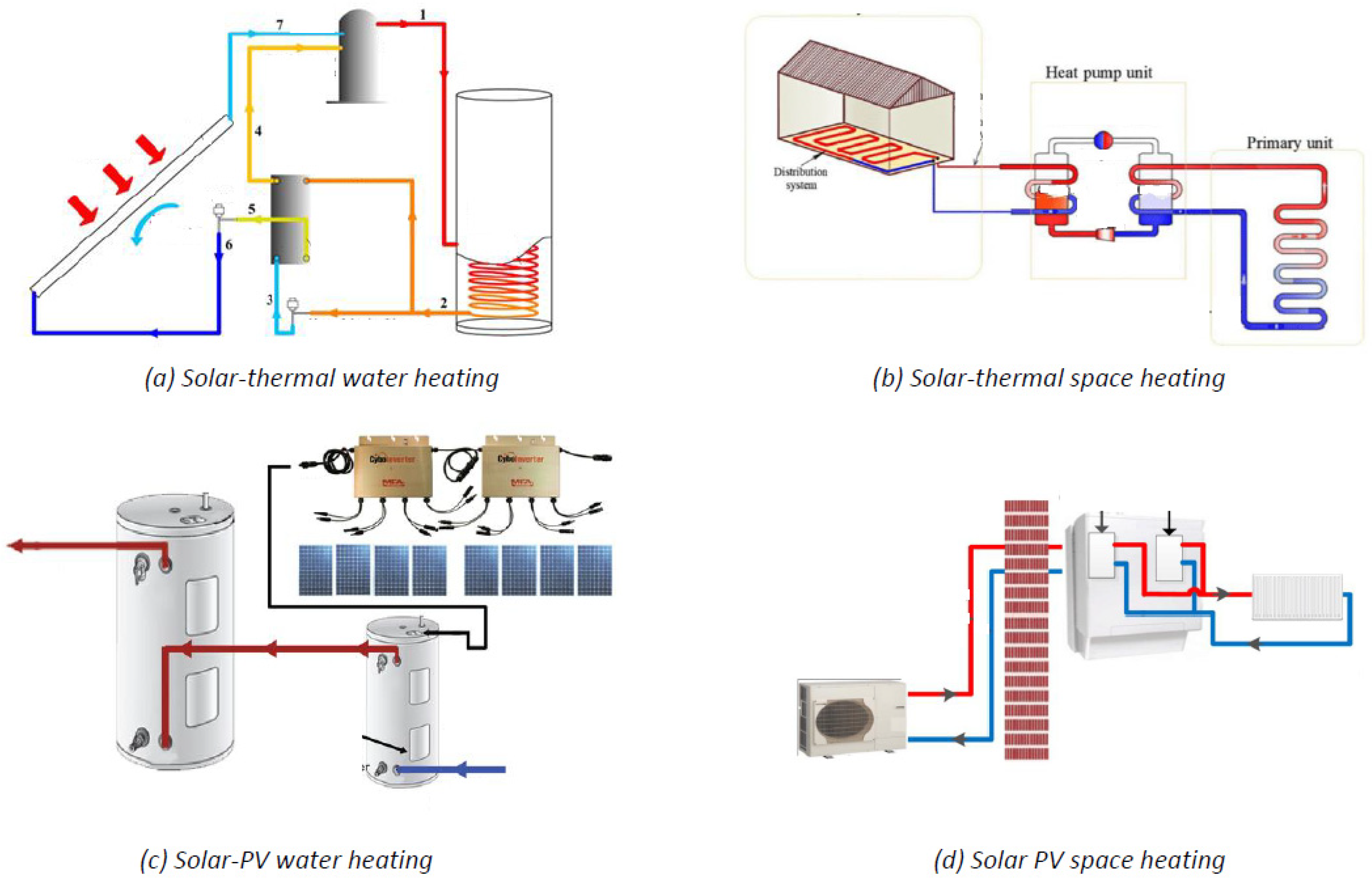
Figure 3. Simulation of solar thermal for (a) water heating and (b) space heating and solar PV for (c) water heating and (d) space heating.
Solar collectors for space heating operate in a temperature range between 40 °C and 90 °C. The operating temperature depends on the type of collector used and the system design. In general, flat collectors operate at lower temperatures, while evacuated tube collectors can operate at higher temperatures due to their higher efficiency. The performance of solar collectors for space heating depends on several factors, such as collector design, orientation, weather conditions, and location. According to a study by Akram et al. [11], the efficiency of solar collectors for space heating varies between 50% and 80%. Additionally, the study reported that the efficiency of evacuated tube collectors was higher than that of flat plate collectors. The energy density of solar collectors for space heating depends on the surface of the collector, solar radiation, and efficiency. According to [12], the energy density of a solar thermal collector for space heating ranges from 50 W/m2 to 1000 W/m2. The study also reported that energy density increases with increasing solar irradiance and collector efficiency. The cost per installed kilowatt of solar collectors for space heating depends on several factors, such as collector type, system design, installation cost, and location. Based on the research presented in [13], the cost per installed kilowatt of solar thermal collectors for space heating ranges between $1200/kW and $2500/kW. It was concluded that the cost per installed kilowatt decreases as the system size increases.
The lifespan of solar space heating collectors depends on several factors, such as the type of collector used, the quality of the materials used, and maintenance practices. The lifetime of solar space heating collectors ranges from 10 to 25 years. The life of evacuated tube collectors was higher than that of flat collectors [14]. The maintenance requirements of solar space heating collectors depend on several factors, such as collector type, system design, and location. They include cleaning the collector surface, checking fluid levels, and inspecting the system for leaks. Although the expenditures are kept at very low levels, they are proportional to the system size in terms of installed capacity [15]. Considering the high initial cost and low operation cost, the life-cycle cost of such systems heavily depends on climatic conditions in different regions, the heater type, and the number of occupants per assessed facility. Consequently, the payback period constitutes a comparable metric between solar collectors, which can be examined with the aid of Table 1 [16].
Table 1. Solar collector features for water heating purposes.
| Collector Type | Outlet Temperature (°C) | Water Tank Temperature (°C) | Efficeiency (%) | Payback Period (yrs) |
|---|---|---|---|---|
| Flat plate | 27–60 | 45–65 | 52–80 | 2.92–4.53 |
| Evacuated tube | 27–60 | 45–65 | 55–80 | 3–10 |
| Compound parabolic | 66–80 | 37–65 | 65–80 | - |
The autonomy in hours for space heating also depends on the size of the collector, the solar radiation, and the design of the system. For space heating, it ranges from 6 to 10 h. Overall, compared with electric heating by utilizing the sun, solar thermal collectors are a sustainable and environmentally friendly source of energy, reducing dependence on fossil fuels and providing a reliable source of energy in remote areas. They can be simply integrated with other renewable energy sources, such as wind and biomass. On the contrary, the indirect conversion of the heat may provide a more flexible use. During the cold months, a heat pump can be turned on via an automated valve and continuously provide the facility with hot water from the solar panels. In the warm months, a heating element can take place and operate as long as needed.
Many households still use heating systems that make use of fossil fuels or electricity, which are becoming increasingly expensive and environmentally harmful. Heat pumps offer an alternative to traditional systems. A space-heating heat pump is an efficient and environmentally friendly way to keep homes warm. Heat pumps can draw heat from the environment, such as air, ground, or water, and use it to heat a space. The operating principle of a heat pump is based on the thermodynamic cycle of refrigeration. The heat pump takes heat from the environment, such as air, ground, or water, and uses a refrigerant to transfer the heat to the space to be heated. The refrigerant is compressed, which raises its temperature, and then flows through a heat exchanger, where it releases heat into the space. The coolant then returns to its original state and is ready to absorb more heat. This cycle repeats as long as the heat pump is running.
The operating temperature of a heat pump for space heating depends on the heat source and the heat sink. In general, the colder the heat source, the more difficult it is to extract heat from it. The ideal temperature range for air-source heat pumps is between 0 °C and 40 °C, while for ground-source heat pumps it is between −5 °C and 25 °C. Water-source heat pumps can operate in a wider temperature range, from −5 °C to 35 °C [17][18]. These temperature ranges may vary depending on the specific model and manufacturer. The efficiency level of a heat pump is measured by the coefficient of performance (COP). COP is the ratio of heat output to energy input. A COP of 3 means that for every unit of input energy, the heat pump produces three units of thermal power. The COP of a heat pump depends on the temperature difference between the heat source and the heat sink. The greater the temperature difference, the lower the COP. For example, a heat pump with a COP of 4 at an outdoor temperature of 7 °C may have a COP of 2 at an outdoor temperature of −7 °C. A heat pump’s COP can also be affected by other factors, such as compressor and heat exchanger performance [19].
4. Water Pumping
A pump is any mechanical means by which it is possible to transfer a quantity of liquid from one altitude level to another that is higher, or from a low-pressure space to another high-pressure one. The problem of wasting energy and water can be found all over the world. Water pumping stations operate mainly empirically, based on the experience of the workers. Such behavior causes energy waste and high operating costs, which are completely undesirable [20][21]. Pumps play a key role in saving both energy and water. They account for 20% of the world’s total energy consumption, and thus their monitoring becomes more important to reduce energy waste. Pump performance deteriorates for a variety of reasons, including cavitation, sludge settling, water hammering, electrical failures, and mechanical failures.
In general, pumps consist of one or more rotating rotors mounted on a shaft, which is driven by an engine and always rotates at the same time inside a housing (chamber, casing). The housing has liquid inlet and outlet openings. Impeller blades of a suitable shape are mounted on the rotating rotor. The rotor, together with the vanes, is called an impeller. As the impeller rotates, the fluid gains angular acceleration, creating a centrifugal force that carries the fluid toward the periphery of the casing to be removed from the outlet opening. As the liquid moves away from the center to the periphery, the pressure in the center decreases, and a new amount of liquid moves towards the low pressure point, resulting in a steady flow [22].
The pumping efficiency decreases when the pumped water has a high temperature. This increases the possibility of creating atmospheric phenomena inside the pump and can lead to reduced water flow and pressure, as well as increased wear and tear on the pump’s internal components. For example, a common pump used in a house to draw water from a source may have an efficiency rating of close to 50–60%. This means that only half to 60% of the energy used by the pump is converted into actual water-pumping work. However, there are more efficient pumps that can have an efficiency rating close to 80–90%, and some specialized pumps can have even higher efficiency ratings. It is important to choose a pump with a high degree of efficiency to reduce energy consumption and save money on the electricity bill [23][24]. Fortunately, the temperature of the water drawn depends on many factors, including the source and the climatic conditions of the area. In general, the temperature of the water at the surface of a body of water, such as a river or lake, can vary significantly depending on the season and climatic conditions. In regions with cold winters, the water temperature can reach freezing temperatures, while on hot summer days it can rise to 20–30 °C [25].
In cases where water is pumped from deep wells or boreholes, the water temperature can be constant throughout the year, as the soil temperature at great depths remains constant relative to climatic conditions. Water pumping is not significantly affected by the temperature of the water being pumped, but temperature can affect pumping performance. However, pumping water can be done with specialized pumps that are designed to meet specific conditions, including water temperature. For example, there are pumps that are specially designed for pumping high-temperature water from geothermal wells or from thermal power plants [26]. Combined with PV for the provision of electrical energy, the major advantages of water pumping systems include: (a) they offer a continuous and uniform movement resulting in constant water flow and pressure; (b) a safe operation is guaranteed and able to be coupled with electric motors and high-speed internal combustion engines or air turbines in case of renewable curtailments; (c) the capital and O&M costs regarding the overall system remain at quite low levels; and (d) they provide good inertia to complete a necessary process before shut down in case of an outage.
Figure 4 shows a typical system consisting of a water pump supplied by PV modules. In remote and isolated areas, the socio-economic benefits become superior since access to clean and safe water for drinking, cooking, washing, and other domestic and industrial uses is achieved in the absence of fossil fuels and at the lowest possible cost. In agricultural and industrial processes, efficiency and utilization factors can increase due to the adjustable nature and control ability of pumps.
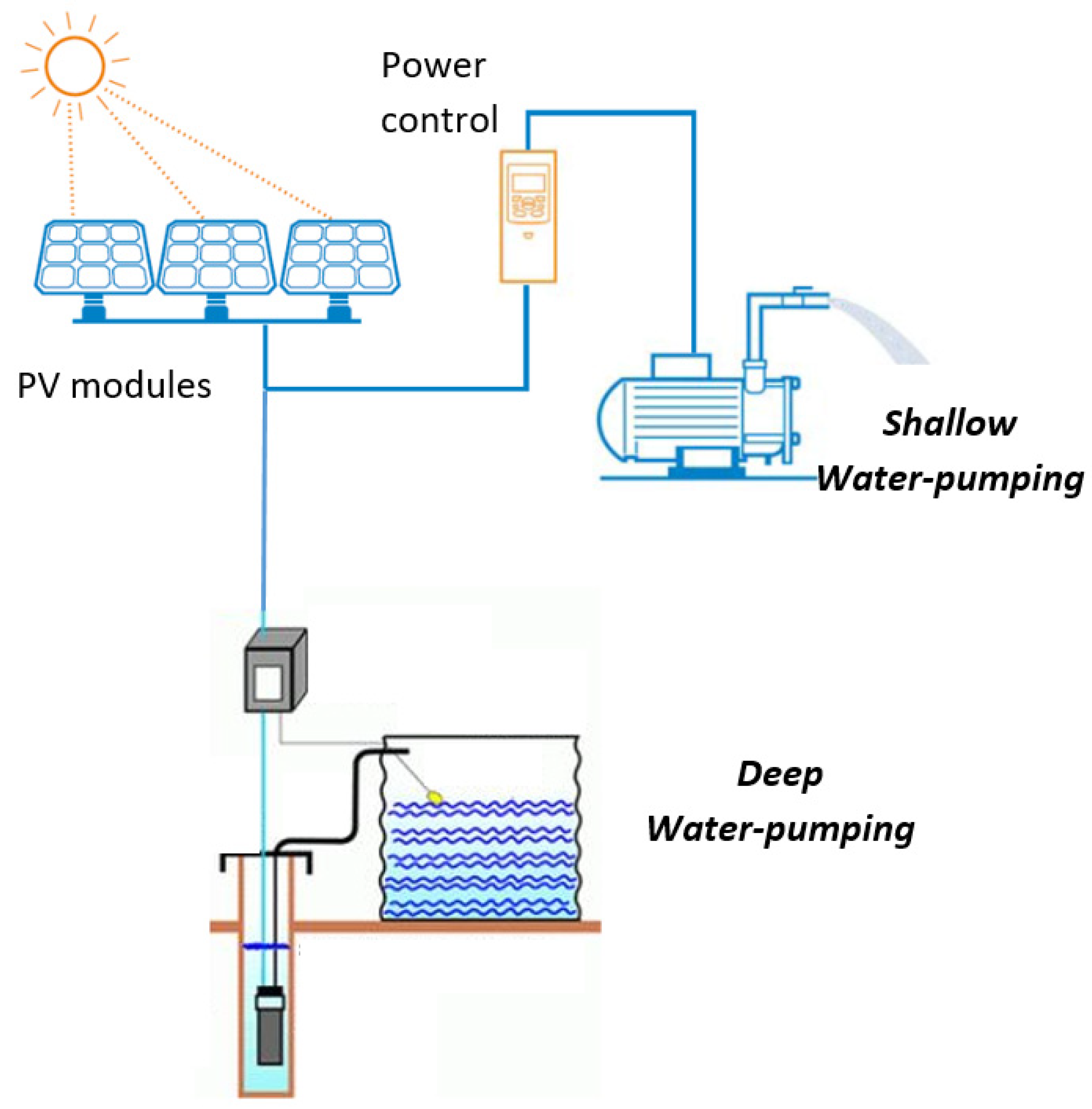
Figure 4. Typical framework for solar PV-water pumping systems.
5. Seawater Desalination
The continued growth of the world’s population and economy has resulted in an increased demand for fresh water. About 70% of the world’s population is expected to face a water deficit by 2025. Almost 50% of the world’s population exists within 200 km of the sea, and only 0.5% of the earth’s water sources are available as clean water for domestic and agricultural needs. Therefore, desalination would be one of the viable options to meet freshwater needs. Desalination is the process of extracting excess salt minerals from salt water, and this technology was commercialized during the Second World War. Different desalination technologies are currently commercialized, and all technologies require energy [27][28].
Reverse osmosis (RO) is a water purification process that uses a semi-permeable membrane to remove dissolved salts, ions, and other impurities from water. It is a form of filtration where water is forced through the membrane, leaving behind contaminants on one side and producing purified water on the other. This process is commonly used in various applications, including desalination of seawater, water treatment, and the production of high-purity water for industrial processes. The heart of the reverse osmosis system is the semi-permeable membrane. This membrane has very tiny pores that allow water molecules to pass through but prevent larger particles, such as salts, minerals, and other impurities, from passing. To initiate the process, external pressure is applied to the water to overcome the natural osmotic pressure. Osmotic pressure is the force that drives water to move from a region of lower solute concentration to a region of higher solute concentration. By applying pressure, the natural osmotic flow is reversed. Water molecules, being smaller than the dissolved salts and impurities, can pass through the membrane and move from the more concentrated side (feed water) to the less concentrated side (purified water). The semi-permeable membrane blocks the larger ions and impurities, allowing only pure water molecules to pass through. The rejected impurities form a concentrated brine or wastewater stream that is discharged separately [29][30].
The chemical reactions in reverse osmosis are primarily physical and not chemical in nature. The process is based on the principles of diffusion and osmosis, which do not involve chemical reactions. The dissolved salts and impurities in water remain in their ionic or molecular form but are physically separated from the water molecules by the membrane. However, there might be some minor chemical reactions that occur due to the presence of certain ions or molecules. For example, some RO membranes have surface functional groups that can interact with specific ions to facilitate or hinder their passage through the membrane [29]. These interactions are more related to the physical properties of the membrane and the dissolved substances than chemical reactions in the traditional sense. A PV desalination plant is depicted in Figure 5 [31]. The system usually consists of the basic elements of solar panels, which constitute the main source of energy; the desalination unit that is used to convert salt water into fresh water through the distillation process; storage tanks for the seawater feed and the fresh water product; piping and valves to link and regulate the flow of water; and several control and monitoring systems to optimally regulate the desalination process, increasing efficiency and lowering cost at a reliable and secure level [28].
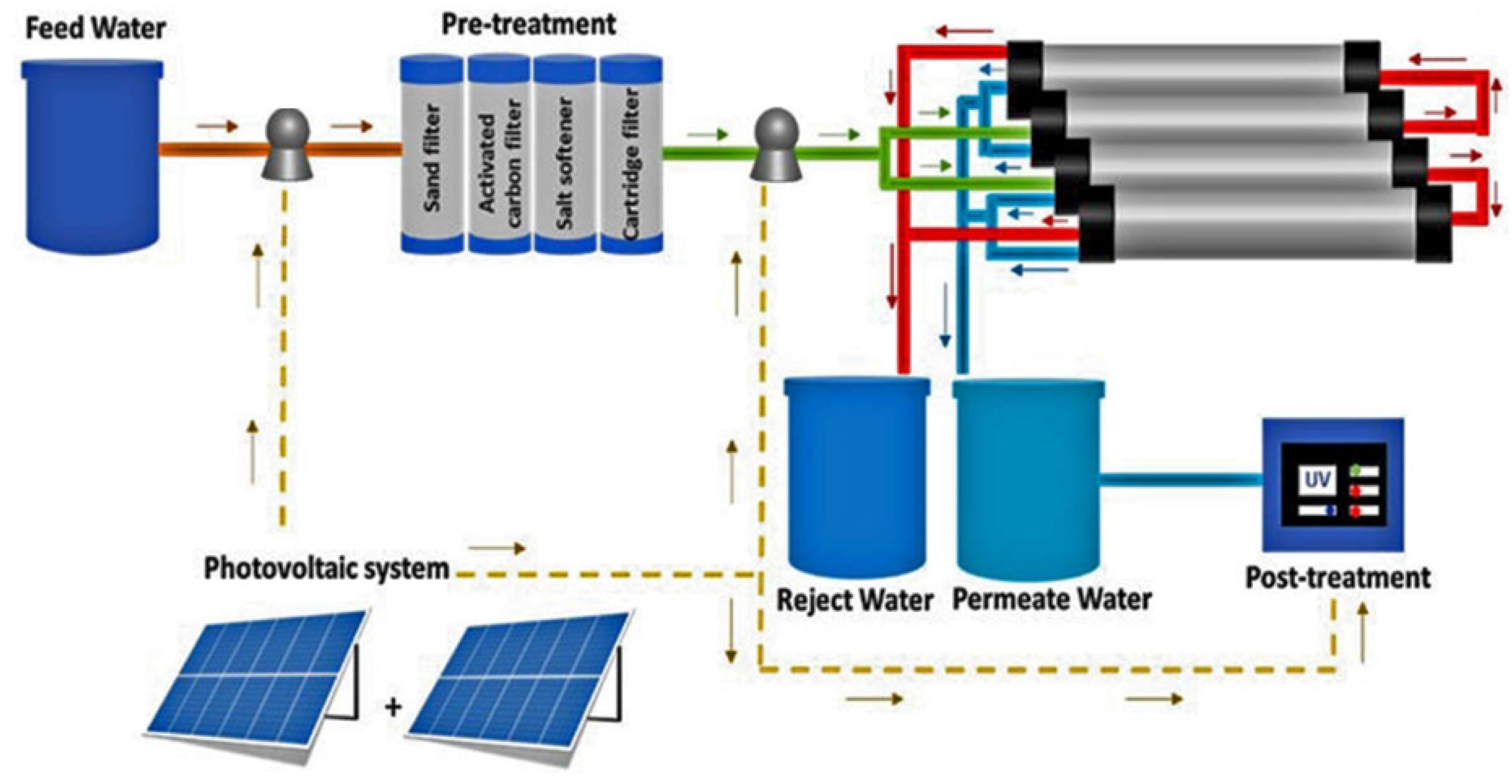
Figure 5. Demonstration of seawater desalination from PV systems.
The efficiency of a solar panel system for combined desalination can vary depending on several factors, such as the efficiency of the solar PV panels, the design of the desalination plant, and the quality of the water source. According to the sources, the efficiency of solar desalination systems can range from 30% to 80%. This can be further deteriorated by decreasing sunlight hours and increasing ambient temperatures. Two representative examples can be seen in Figure 6, where the hourly variation in temperature and incident solar radiation is given for summer and winter days.
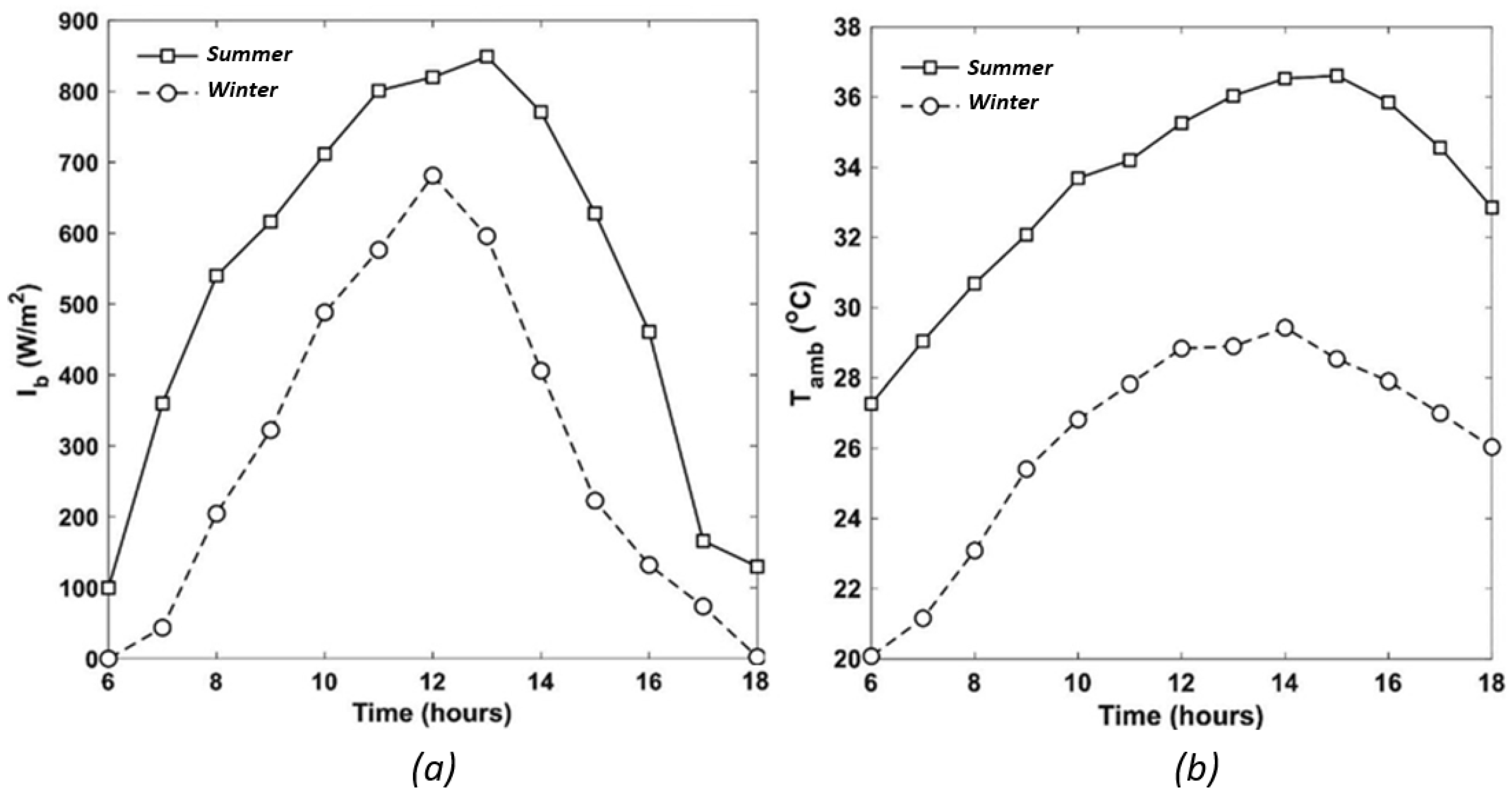
Figure 6. Hourly variation of incident (a) solar radiation and (b) temperature.
6. Solar Cooking
Solar cookers are an environmentally friendly and economical alternative to traditional cooking methods. They use solar energy to cook food, reducing the need for fossil fuel combustion and consequent GHG emissions. However, the performance of solar cookers can vary depending on the design and materials used. In Figure 7, some innovative designs for solar cooking systems are illustrated.
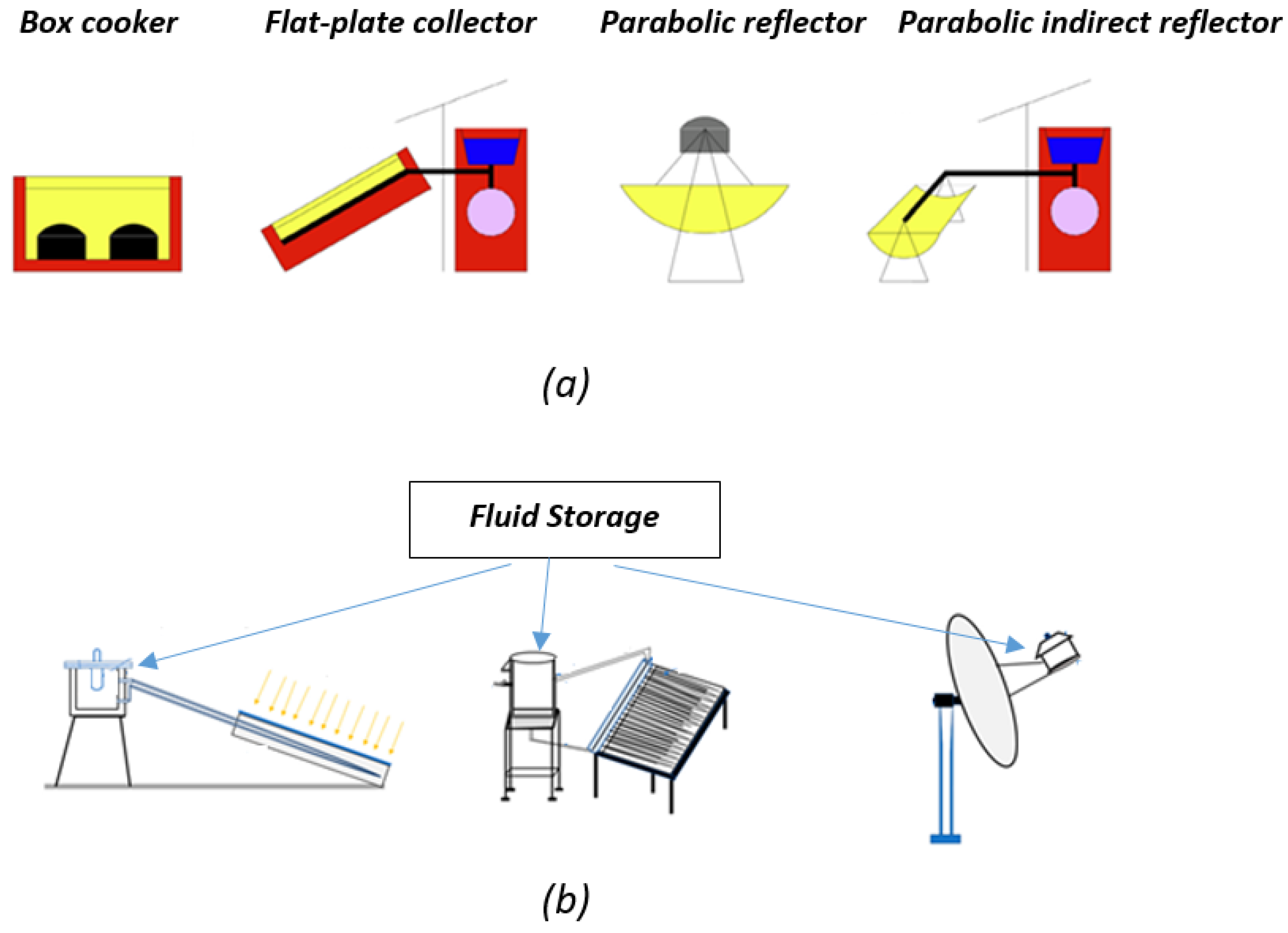
Figure 7. Main topologies for solar cooking (a) without and (b) with thermal storage.
Solar box-cooker types are the most common type of solar kitchen. They consist of an insulated box with a transparent lid, which allows sunlight to enter and heat the cooking chamber. The efficiency of a box-type solar cooker can range from 20% to 40%. Efficiency can be improved by using a reflector to direct more sunlight into the cooking chamber [32]. Following are the parabolic solar cookers, which use a parabolic reflector to focus sunlight onto a cooking vessel. The efficiency of a parabolic solar cooker can range from 25% to 45%. Performance can be improved by using a tracking mechanism to keep the reflector pointed at the sun. The next category involves funnel-type solar cookers and rectangular cookers that are capable of using multiple reflectors to direct sunlight into a cooking vessel. The efficiency of a solar-panel cooker of this type can range between 25% and 40%. Their overall performance can be improved by using a larger reflector and optimizing the angle of the reflectors. Finally, the hybrid solar cookers combine solar energy with other heat sources such as biomass or electricity. The efficiency of a hybrid solar cooker can range between 30% and 50% and can be increased by optimizing the combination of solar and other heat sources.
The temperature range for solar cooking was found to be between 100 and 120 °C. Studies also found that the performance of solar cookers increased with increasing cooking temperatures, suggesting that a higher temperature is desirable for effective solar cooking [33]. The temperature achieved during solar cooking can vary depending on the type of solar cooker used. The temperature in parabolic solar cookers can reach up to 300 °C, while box-type solar cookers have a lower temperature range of up to 120 °C [34]. In addition, the operating temperature for solar cooking strongly depends on the insulating material used in the solar cooker. The use of insulating material increases the temperature inside the solar cooker, reducing heat loss, which improves the efficiency of solar cooking. Overall, the operating temperature of solar cooking is affected by several factors, such as the type of solar cooker used, geographic location, weather conditions, type of food being cooked, and insulation materials. However, most of the studies report an operating temperature range of 100–150 °C for solar cooking [35].
While solar cookers may initially be more expensive investments than traditional cooking methods, they can save money in the long term. Solar cookers use free, renewable energy from the sun, meaning they require no fuel or electricity. This can lead to significant cost savings, especially for people living in areas where fuel or electricity are expensive or difficult to access. Moreover, solar cookers have a longer lifespan than traditional cooktops, which require frequent maintenance and replacement. Also, solar cookers do not emit harmful pollutants, which can lead to health problems and incur additional medical costs. In contrast to the capital costs, the O&M costs make their employment viable in combination with their long lifespan, which exceeds ten years in most cases, according to the type.
Solar cooking has emerged as a sustainable and environmentally friendly method of cooking food, especially in areas with abundant sunlight. It is relatively cheap to build and requires no operating costs, eliminating the need for open stoves, which can pollute indoor air and lead to respiratory problems. It provides a means of cooking food without relying on the electrical grid, making it ideal for remote and off-grid areas. A significant advantage is the lack of open flames, which makes solar cooking safer than traditional cooking methods, especially for children. On the negative side, it is highly dependent on sunlight, making it less effective on cloudy or rainy days. Also, cooking times are generally longer with solar cookers compared with traditional methods, which can be a disadvantage for those with limited time. Solar kitchens have limited capacity and are not ideal for cooking large quantities of food [32][36]. However, research and development (R&D) programs are already focused on storage candidates. Currently, the most competitive materials are materials with high heat capacity that are able to store vast amounts of solar energy in their mass. Next-generation cookers may concern phase change materials (PCM), the principal operation of which will be examined in the following sections.
7. Solar Lighting
Natural sunlight is beneficial for human health and well-being, as well as for showcasing colors accurately in indoor spaces. Solar lighting tubes, also known as solar tubes, sun tubes, or light pipes, are innovative daylighting systems that bring natural sunlight into interior spaces that might not have access to traditional windows or skylights. These tubes use a combination of reflective surfaces and optical technologies to capture sunlight from outside and then transfer it indoors, providing illumination without consuming electricity. They are particularly useful for areas like windowless rooms, hallways, closets, and other spaces where natural light is limited or unavailable.
Solar lighting finds ready application in residential, commercial, and industrial sectors by making use of tubular devices, which mainly exploit some lenses to form different topologies and modern designs. A dome or collector located on the roof or exterior of a building is designed to capture sunlight. This dome is usually made of a transparent material that allows sunlight to enter while protecting the interior from the elements. The captured sunlight is then directed downward through a highly reflective tube or pipe. This reflective tube ensures that light is effectively bounced along its surface, even if the tube bends or turns, maximizing the amount of light that reaches the interior space. As the sunlight travels down the tube, it is diffused to provide even lighting throughout the interior space. Some solar tubes incorporate diffusers or lens systems that spread the light and reduce glare, creating a soft and natural illumination similar to regular daylight. This offers the ability to operate even on cloudy days [37]. At the end of the tube inside the building, there is an interior fixture that distributes the diffused sunlight into the room. This fixture is designed to seamlessly blend with the interior décor.
A basic paradigm is depicted in Figure 8. Utilizing these topologies, three main operations are offered: daylight supply, dimmer capability, and emergency nightlight. Specifically, the whole lens system is activated to effectively transport the maximum natural light using on/off services. The ability to adjust the brightness is provided by appropriately selected lenses choosing the dimming function, whereas in spaces like hallways, closets, or bathrooms, the residence’s way is lit up via a mini PV-battery-supported system. Regarding the advantages, the most important merit of solar lighting tubes is that they can transport sunlight through pipes, absorbing only the useful energy for lighting purposes and rejecting heat. In addition, solar tubes require no electricity to operate, making them a highly energy-efficient system as well as an environmentally friendly solution. Moreover, they can be particularly useful for spaces where privacy is important, as they allow light to enter without compromising privacy like windows or other openings [38].
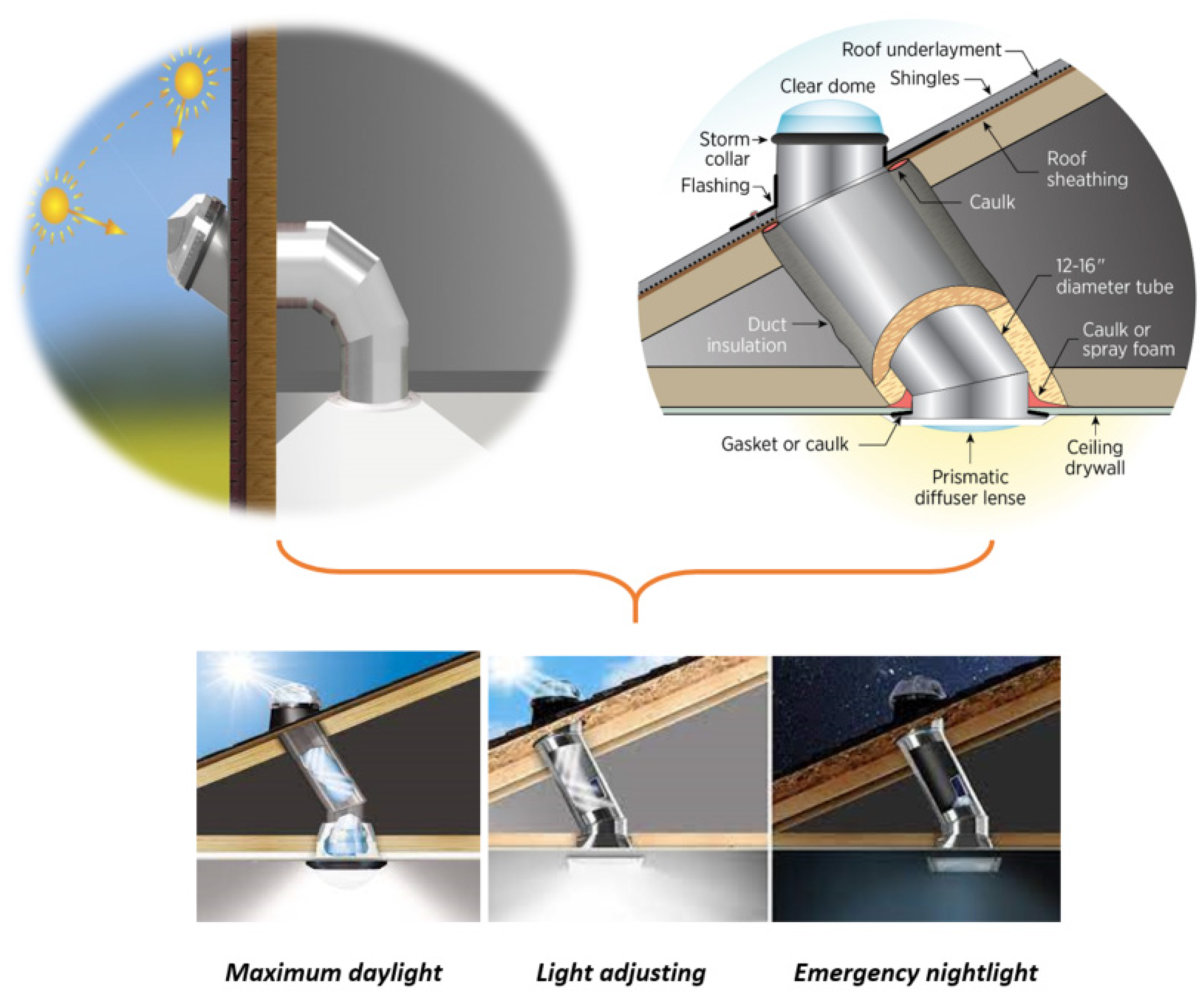
Figure 8. Principal function of solar tubes in lighting services.
References
- Tounta, E.-N. Green Smart Home: Systems, Materials and Simulation Design. 2022. Available online: https://polynoe.lib.uniwa.gr/xmlui/handle/11400/2798 (accessed on 6 August 2023).
- Dan, D.; Tanasa, C.; Stoian, V.; Brata, S.; Stoian, D.; Nagy Gyorgy, T.; Florut, S.C. Passive house design-An efficient solution for residential buildings in Romania. Energy Sustain. Dev. 2016, 32, 99–109.
- Müller, L.; Berker, T. Passive House at the crossroads: The past and the present of a voluntary standard that managed to bridge the energy efficiency gap. Energy Policy 2013, 60, 586–593.
- Zacharopoulou, K. Passive Buildings as Models for Energy Upgrade of Buildings in Greece; University of West Attica: Aigaleo, Greece, 2021.
- Georgiou, G.S.; Nikolaidis, P.; Lazari, L.; Christodoulides, P. A Genetic Algorithm Driven Linear Programming for Battery Optimal Scheduling in nearly Zero Energy Buildings. In Proceedings of the 2019 54th International Universities Power Engineering Conference, UPEC 2019—Proceedings, Bucharest, Romania, 3–6 September 2019; pp. 1–6.
- Silva, S.M.; Mateus, R.; Marques, L.; Ramos, M.; Almeida, M. Contribution of the solar systems to the nZEB and ZEB design concept in Portugal—Energy, economics and environmental life cycle analysis. Sol. Energy Mater. Sol. Cells 2016, 156, 59–74.
- Irfan, M.; Abas, N.; Saleem, M.S. Net Zero Energy Buildings (NZEB): A Case Study of Net Zero Energy Home in Pakistan. In Proceedings of the 2018 International Conference on Power Generation Systems and Renewable Energy Technologies (PGSRET), Islamabad, Pakistan, 10–12 September 2018; pp. 1–6.
- Georgiou, G.S.; Nikolaidis, P.; Kalogirou, S.A.; Christodoulides, P. A hybrid optimization approach for autonomy enhancement of nearly-zero-energy buildings based on battery performance and artificial neural networks. Energies 2020, 13, 3680.
- da Cunha, S.R.L.; de Aguiar, J.L.B. Phase change materials and energy efficiency of buildings: A review of knowledge. J. Energy Storage 2020, 27, 101083.
- Bontemps, A.; Ahmad, M.; Johanns, K.; Sallée, H. Experimental and modelling study of twin cells with latent heat storage walls. Energy Build. 2011, 43, 2456–2461.
- Mekhilef, S.; Saidur, R.; Safari, A. A review on solar energy use in industries. Renew. Sustain. Energy Rev. 2011, 15, 1777–1790.
- Zhou, X.; Xu, Y.; Zhang, X.; Xu, D.; Linghu, Y.; Guo, H.; Wang, Z.; Chen, H. Large scale underground seasonal thermal energy storage in China. J. Energy Storage 2021, 33, 102026.
- Zayed, M.E.; Zhao, J.; Elsheikh, A.H.; Hammad, F.A.; Ma, L.; Du, Y.; Kabeel, A.E.; Shalaby, S.M. Applications of cascaded phase change materials in solar water collector storage tanks: A review. Sol. Energy Mater. Sol. Cells 2019, 199, 24–49.
- Kumar, L.; Hasanuzzaman, M.; Rahim, N.A. Global advancement of solar thermal energy technologies for industrial process heat and its future prospects: A review. Energy Convers. Manag. 2019, 195, 885–908.
- Hu, M.; Zhao, B.; Ao, X.; Ren, X.; Cao, J.; Wang, Q.; Su, Y.; Pei, G. Performance assessment of a trifunctional system integrating solar PV, solar thermal, and radiative sky cooling. Appl. Energy 2020, 260, 114167.
- Ge, T.S.; Wang, R.Z.; Xu, Z.Y.; Pan, Q.W.; Du, S.; Chen, X.M.; Ma, T.; Wu, X.N.; Sun, X.L.; Chen, J.F. Solar heating and cooling: Present and future development. Renew. Energy 2018, 126, 1126–1140.
- Mustafa Omer, A. Ground-source heat pumps systems and applications. Renew. Sustain. Energy Rev. 2008, 12, 344–371.
- Schibuola, L.; Scarpa, M. Experimental analysis of the performances of a surface water source heat pump. Energy Build. 2016, 113, 182–188.
- Tan, Z.; Feng, X.; Wang, Y. Performance comparison of different heat pumps in low-temperature waste heat recovery. Renew. Sustain. Energy Rev. 2021, 152, 111634.
- De Oliveira Turci, L.; Sun, H.; Bai, M.; Wang, J.; Hu, P. Water pump station scheduling optimization using an improved genetic algorithm approach. In Proceedings of the 2019 IEEE Congress on Evolutionary Computation (CEC), Wellington, New Zealand, 10–13 June 2019; pp. 944–951.
- Subramaniam, U.; Dutta, N.; Padmanaban, S.; Almakhles, D.; Kyslan, K.; Fedak, V. Identification of sludge in water pumping system using support vector machine. In Proceedings of the 2019 International Conference on Electrical Drives & Power Electronics (EDPE), The High Tatras, Slovakia, 24–26 September 2019; pp. 403–408.
- Pavlos, N. Sustainable services to enhance flexibility in the upcoming smart grids. In Sustaining Resources for Tomorrow; Springer: Cham, Switzrland, 2020; pp. 245–274.
- Meah, K.; Fletcher, S.; Ula, S. Solar photovoltaic water pumping for remote locations. Renew. Sustain. Energy Rev. 2008, 12, 472–487.
- Gao, X.; Liu, J.; Zhang, J.; Yan, J.; Bao, S.; Xu, H.; Qin, T. Feasibility evaluation of solar photovoltaic pumping irrigation system based on analysis of dynamic variation of groundwater table. Appl. Energy 2013, 105, 182–193.
- Angadi, S. Comprehensive Review on Solar, Wind and Hybrid Wind-PV Water Pumping Systems-An Electrical Engineering Perspective. CPSS Trans. Power Electron. Appl. 2021, 6, 1–19.
- Chandel, S.S.; Nagaraju Naik, M.; Chandel, R. Review of solar photovoltaic water pumping system technology for irrigation and community drinking water supplies. Renew. Sustain. Energy Rev. 2015, 49, 1084–1099.
- Anand, B.; Shankar, R.; Murugavelh, S.; Rivera, W.; Midhun Prasad, K.; Nagarajan, R. A review on solar photovoltaic thermal integrated desalination technologies. Renew. Sustain. Energy Rev. 2021, 141, 110787.
- Alawad, S.M.; Mansour, R.B.; Al-Sulaiman, F.A.; Rehman, S. Renewable energy systems for water desalination applications: A comprehensive review. Energy Convers. Manag. 2023, 286, 117035.
- Tałałaj, I.A.; Biedka, P.; Bartkowska, I. Treatment of landfill leachates with biological pretreatments and reverse osmosis. Environ. Chem. Lett. 2019, 17, 1177–1193.
- Adel, M.; Nada, T.; Amin, S.; Anwar, T.; Mohamed, A.A. Characterization of fouling for a full-scale seawater reverse osmosis plant on the Mediterranean sea: Membrane autopsy and chemical cleaning efficiency. Groundw. Sustain. Dev. 2022, 16, 100704.
- Armendáriz-Ontiveros, M.M.; Dévora-Isiordia, G.E.; Rodríguez-López, J.; Sánchez-Duarte, R.G.; Álvarez-Sánchez, J.; Villegas-Peralta, Y.; Martínez-Macias, M. del R. Effect of Temperature on Energy Consumption and Polarization in Reverse Osmosis Desalination Using a Spray-Cooled Photovoltaic System. Energies 2022, 15, 7787.
- Aramesh, M.; Ghalebani, M.; Kasaeian, A.; Zamani, H.; Lorenzini, G.; Mahian, O.; Wongwises, S. A review of recent advances in solar cooking technology. Renew. Energy 2019, 140, 419–435.
- Sansaniwal, S.K.; Sharma, V.; Mathur, J. Energy and exergy analyses of various typical solar energy applications: A comprehensive review. Renew. Sustain. Energy Rev. 2018, 82, 1576–1601.
- Lentswe, K.; Mawire, A.; Owusu, P.; Shobo, A. A review of parabolic solar cookers with thermal energy storage. Heliyon 2021, 7, e08226.
- Mendoza, J.M.F.; Gallego-Schmid, A.; Schmidt Rivera, X.C.; Rieradevall, J.; Azapagic, A. Sustainability assessment of home-made solar cookers for use in developed countries. Sci. Total Environ. 2019, 648, 184–196.
- Vanschoenwinkel, J.; Lizin, S.; Swinnen, G.; Azadi, H.; Van Passel, S. Solar cooking in Senegalese villages: An application of best-worst scaling. Energy Policy 2014, 67, 447–458.
- Wu, Y. Research and development of solar light pipes in China. In Proceedings of the 2008 International Conference on Information Management, Innovation Management and Industrial Engineering, Taipei, Taiwan, 19–21 December 2008; Volume 3, pp. 146–149.
- Mohapatra, B.N.; Ravi Kumar, M.; Mandal, S.K. Analysis of light tubes in interior daylighting system for building. Indones. J. Electr. Eng. Comput. Sci. 2019, 17, 710–719.
More
Information
Subjects:
Energy & Fuels
Contributor
MDPI registered users' name will be linked to their SciProfiles pages. To register with us, please refer to https://encyclopedia.pub/register
:
View Times:
1.3K
Revisions:
2 times
(View History)
Update Date:
27 Sep 2023
Notice
You are not a member of the advisory board for this topic. If you want to update advisory board member profile, please contact office@encyclopedia.pub.
OK
Confirm
Only members of the Encyclopedia advisory board for this topic are allowed to note entries. Would you like to become an advisory board member of the Encyclopedia?
Yes
No
${ textCharacter }/${ maxCharacter }
Submit
Cancel
Back
Comments
${ item }
|
More
No more~
There is no comment~
${ textCharacter }/${ maxCharacter }
Submit
Cancel
${ selectedItem.replyTextCharacter }/${ selectedItem.replyMaxCharacter }
Submit
Cancel
Confirm
Are you sure to Delete?
Yes
No




